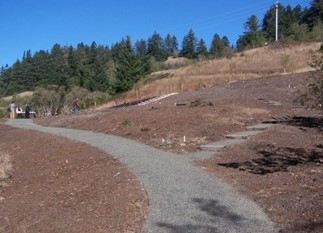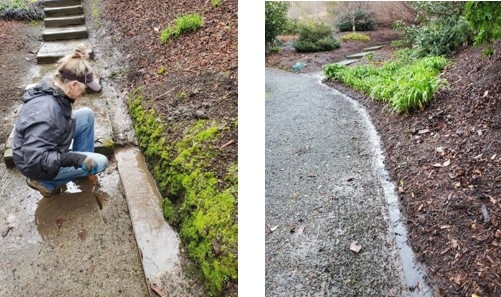Why, what's the matter, 
That you have such a February face,
So full of frost, of storm and cloudiness?
–William Shakespeare, from "Much Ado About Nothing"
Back in 2008, when we first began to garden, plan, and plant the Moss Family Temperate Woodland Garden in Humboldt Botanical Garden, we had a bare canvas and mostly bare earth except for the amazing load of weed seeds from the native soil and the many loads of trucked-in horse-barn shavings, spoiled feed, and manure.
We learned quickly that water flows downhill and over our beautifully compacted and rocked pathways and stairs. As the water flowed, it carried soil, eroded our new paths, and sought and took its own path. We learned where the water would run all year and where it would only run until the first of summer, and we learned to take advantage of its special qualities and behaviors.
Tim and I had been to Pukeiti Garden in New Zealand (https://www.trc.govt.nz/gardens/pukeiti/), where the prodigious rain (4 meters or 160 inches) caused the gardeners to dig 3-foot-deep and wide ‘gutters' along their pathways. They also had large culverts where the pathways crossed the rain flow. We and our volunteers learned to use trenching tools to cut gutters along our pathways to give the water a place to run without too much destruction.
When considering how to manage water runoff, think about slowing down the flow of the water, creating low-lying areas in the garden to provide short-term storage for heavy runoff, and allowing sediment and water to soak into the ground instead of entering storm drains and creeks. Also, consider planting plants with fibrous root systems along the edges to prevent runoff and soil erosion. For more information, visit https://ccuh.ucdavis.edu/sites/g/files/dgvnsk1376/files/inline-files/landdesign%20water%20quality%20english.pdf
This time of year, keeping our 16-year-old gutters free of debris is a major task for our volunteers and staff. Luckily, our deciduous trees are finished with their fall disrobement and the leaves have been removed from gutters and pathways by the Wild Weeders and Grateful Deadheaders. The leaves are repurposed into the garden beds.
During our Docent-led tour on Saturday, February 3rd, we saw the blooming Camellia reticulata along the road and the first of our brilliant pink Magnolia sprengeri var. diva 'Diva' and Magnolia ‘Caerhay's Belle' (M. sargentiana var. robusta × M. sprengeri ‘Diva'. These plants give the garden dramatic pops of color on otherwise dreary days. Tim says, “The joy of these magnolias is that they bloom in February, and the sorrow is that they bloom in February as wind and rain can strip the flowers.”
Soon the Wild Weeders and Grateful Deadheaders will begin their annual Camellia purgatory of spent blossom cleanup. We pick up the spent flowers to help prevent Camellia petal blight which is a disease caused by the fungus Ciborinia camelliae. Though our C. reticulatas are less susceptible than C. japonica or the Williams hybrids, we want to do what we can to prevent our flowers from turning brown and falling off prematurely.
Come visit the temperate woodland garden at Humboldt Botanical Garden to see how we manage water run-off, maintain the plants and soil, enjoy the lovely blossoms, and see how the garden changes throughout the seasons.
Resources:
Landscape Design & Water Quality
https://ccuh.ucdavis.edu/sites/g/files/dgvnsk1376/files/inline-files/landdesign%20water%20quality%20english.pdf
Landscape Plants: Fertilizing & Watering
https://ccuh.ucdavis.edu/sites/g/files/dgvnsk1376/files/inline-files/landplants%20fertilizing%20watering%20english.pdf
Soak Up the Rain: Rain Gardens
https://www.epa.gov/soakuptherain/soak-rain-rain-gardens
